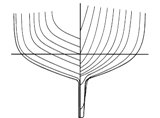

Malua - an Adams cruising yacht


Malua - an Adams cruising yacht
Malua was shipped from Australia to Palma in Majorca in Spain.
Steaming towards the Erasmusgracht secured along side Darling
harbour in the dawn light I realised we had finally arrived at the end
of the Australian chapter of the Malua story. It was so exciting. The
next time I would be sailing Malua it would be in Europe on the
Mediterranean and that would be only 40 days away!
We arrived alongside to find a 43ft yacht already on the vessel and the
stevedores struggling to load a power boat. They did not have the
correct loading equipment and it appeared as if they did not have the
experience with loading vessels from out of the water on to a ship.
The Australian water front has been plagued with industrial and
demarcation issues. Only certain groups of union staff are permitted to
do designated tasks. This was evident today. The Master of the
Erasmusgracht and the load master from Sevenstar had to hold their
tongues as the P&O crew struggled to load the powerboat.
We
stayed alongside the ship waiting our turn to be lifted out of the
water.
The mast of Malua and the temporary backstays appeared to pose a
problem for the stevedores. They asked me to remove the backstays but I
refused and suggested that the current lifting rig should be change to
a more suitable arrangement for yachts. There was a long delay but
after more than an hour the correct lifting rig appeared attached to
the ships cranes. I was relieved.
The stevedore crew came aboard and
with the help of the divers and my marks on the hull we soon had the
slings in the correct place. The crane slowly lifted Malua out of the
water as we tested the weight distribution and how secure the rig was.
It was time to leave Malua as they hosted it up over the side of the
ship. The fourth time Malua has flown from the end of a
crane’s slings (in and out of my yard in Canberra during the
fit-out phase of building).
On Board Securing Malua
On board the ship the Master organised the securing of Malua. The
cradle was welded to the ship and eight straps used to tie down the
yacht to the ship. I re-connected the back stay, removed the genoa
halyard and used the main halyard as a backstay. The anchor was placed
in the locker, the fenders put away and the lockers masked up to keep
the water out. I then closed all the through-hulls, turned off the
power and closed the companionway for the last time. The loading and
securing was complete. I could relax.
We waited around to watch the
other yachts being loaded. There was a 40 ft racing machine, a Swan 45
and finally a 83ft Oyster called Darling. While being long it was also
heavy at 65 tonnes. The ship required two cranes to lift it on to the
deck. As it was raised out of the water the ship listed to starboard
under the weight. Slowly the yacht was lowered onto the deck and
secured.
The Erasmusgracht will complete the loading on Friday and leave on
Saturday for Tauranga in New Zealand then on through the Panama to
Palma de Mallorca in Spain arriving some time towards the end of March.
Click her to enter the Mediterranean.
or follow us in the Barearic.